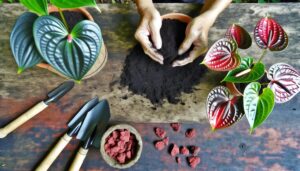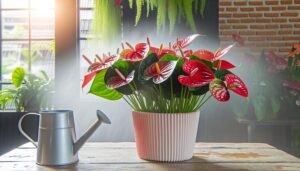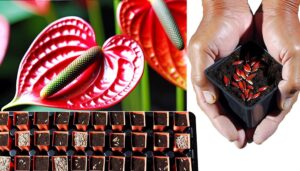The Perfect Soil Mix for Thriving Anthuriums: Complete Guide
To guarantee Anthuriums flourish, create a soil mix that mirrors their tropical environment. Start with 40% coconut coir for water retention and aeration.
Add 30% orchid bark to improve drainage and 20% perlite for enhanced porosity. Incorporate 10% charcoal to prevent root rot.
Achieve a pH between 5.5 and 6.5 by regularly testing and adjusting with sulfur or lime. This blend balances moisture, nutrient release, and root oxygenation, promoting healthy growth.
Use pots with drainage holes to avoid waterlogging. Keep exploring to discover more about optimizing your Anthurium’s soil and overall care.
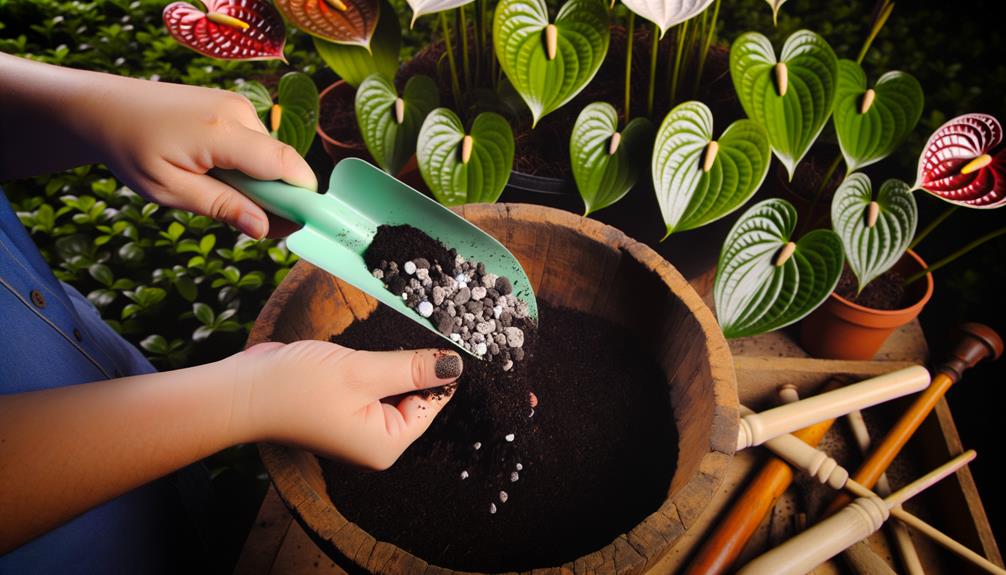
Key Takeaways
- Use a soil blend of 40% coconut coir, 30% orchid bark, 20% perlite, and 10% charcoal for optimal aeration and moisture.
- Maintain soil pH between 5.5 and 6.5 by testing regularly and adjusting with sulfur or lime if necessary.
- Incorporate 30-40% organic matter like peat moss and compost to enhance soil structure and nutrient availability.
- Ensure proper drainage by adding perlite or coarse sand and using pots with drainage holes to prevent waterlogging.
- Include sphagnum peat moss and horticultural charcoal to improve moisture retention and support healthy root development.
Understanding Anthurium Needs
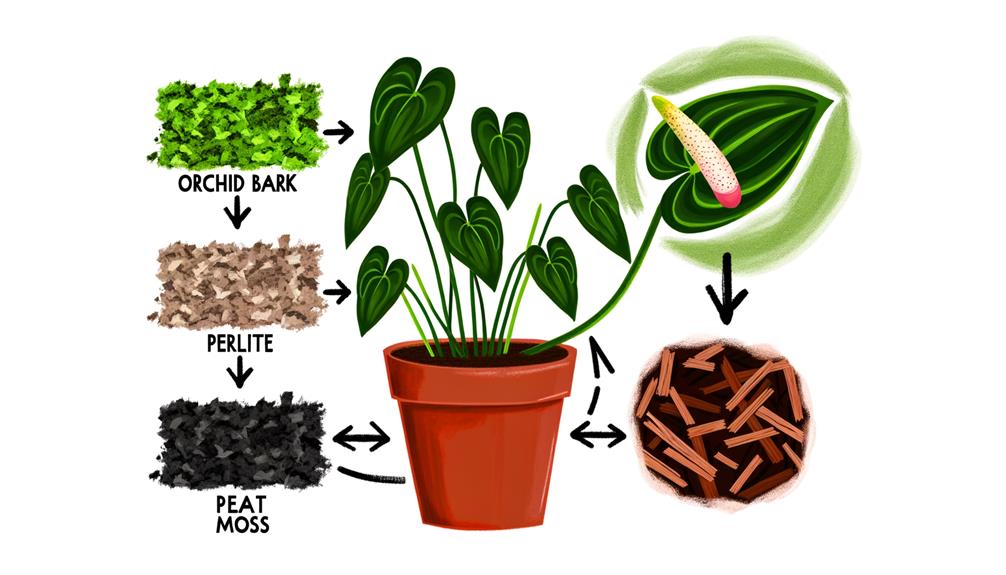
To cultivate healthy Anthuriums, you must first understand their unique requirements for moisture, light, and soil composition.
Anthuriums thrive in humid environments, so maintaining consistent moisture levels is essential. You’ll need to water them thoroughly but guarantee the pot has excellent drainage to prevent root rot.
Place them in bright, indirect light; direct sunlight can scorch their leaves while insufficient light stunts growth.
The soil must be well-aerated and rich in organic matter to mimic their natural epiphytic habitat.
Achieving a balance in light exposure and moisture retention while avoiding waterlogging will greatly enhance the plant’s vitality. By mastering these conditions, you’ll assure your Anthuriums flourish and contribute to the well-being of those you serve.
Essential Soil Components
To maximize your anthuriums thrive, focus on incorporating organic matter like peat moss and compost, which boosts nutrient content.
Implement proper drainage techniques using materials such as perlite or orchid bark to prevent waterlogging.
Maintain ideal pH levels between 5.5 and 6.5 to facilitate nutrient uptake and root development.
Organic Matter Importance
Incorporating organic material into your soil blend is crucial for providing anthuriums with the nutrients and moisture retention they need to thrive.
Organic material, such as compost, peat moss, and coconut coir, greatly enhances soil structure by improving aeration and water-holding capacity. These components decompose slowly, releasing essential macro and micronutrients over time, which supports robust growth and vibrant blooms.
You should aim for a balanced mix, roughly 30-40% organic material, to maximize soil fertility. Additionally, organic material promotes beneficial microbial activity, breaking down complex organic compounds into plant-available forms.
Proper Drainage Techniques
While organic matter enriches the soil, maintaining proper drainage is equally crucial to prevent waterlogging and root rot in your anthuriums. Start with a well-ventilated mix; incorporating perlite or coarse sand enhances soil porosity.
Use orchid bark to add texture, facilitating air circulation around the roots. You’ll also benefit from adding charcoal, which assists in moisture regulation and toxin absorption.
Make sure your pot has drainage holes to allow excess water to escape. Elevate the pot slightly to ensure water doesn’t accumulate underneath. Regularly check the drainage efficiency by watering your anthurium and observing how swiftly the water exits.
Ideal Ph Levels
Maintaining an ideal pH level between 5.5 and 6.5 is crucial for the healthy growth of Anthuriums, as it guarantees the efficient uptake of essential nutrients. You should regularly test the soil using a pH meter or pH test strips, both of which provide accurate readings.
If the pH is too high, you can lower it by incorporating organic materials like peat moss or sulfur. Conversely, if the pH is too low, adding lime or dolomitic limestone will help balance it. Always adjust the pH gradually and retest after each adjustment.
This precise approach ensures Anthuriums thrive, fostering robust foliage and vibrant blooms, essential for creating beautiful arrangements and serving your clients with excellence.
Choosing the Right Potting Medium
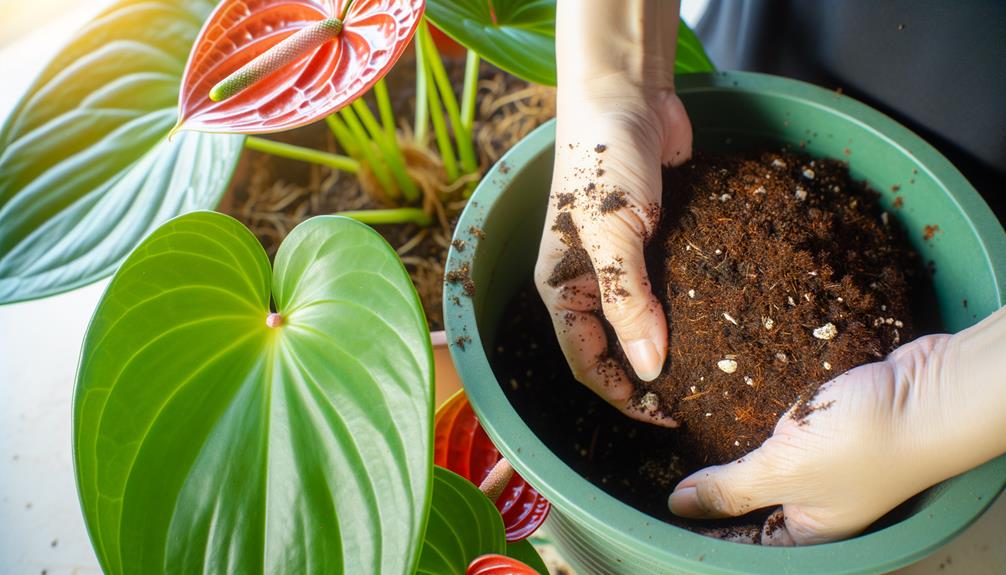
When selecting the appropriate potting medium for Anthuriums, concentrate on a mixture that includes crucial components like orchid bark, peat moss, and perlite. These elements guarantee ideal soil texture, offering superb aeration and moisture retention.
You’ll need to balance these factors carefully to replicate the plant’s natural epiphytic habitat.
Essential Ingredients Breakdown
Choosing the correct potting medium for your anthuriums involves combining ingredients that guarantee ideal aeration, drainage, and nutrient availability.
Start with a base of peat moss or coconut coir, both of which retain moisture without waterlogging.
Add perlite or pumice to enhance drainage and prevent root rot.
Incorporate orchid bark to promote air circulation around the roots, essential for healthy growth.
For added nutrients, mix in a small amount of compost or worm castings.
Finally, charcoal helps filter impurities and maintain a balanced pH.
Optimal Soil Texture
A well-balanced soil texture for anthuriums demands a blend that provides excellent aeration, moisture retention, and nutrient availability.
Start with a base of coarse pine bark, which offers superior drainage while preventing root rot.
Mix in sphagnum peat moss to retain moisture and supply essential organic matter.
Add perlite to enhance aeration and prevent compaction, ensuring roots get enough oxygen.
Consider incorporating charcoal to absorb impurities and improve soil structure.
Avoid heavy, clay-based soils as they can suffocate roots.
Regularly monitor your soil’s pH, aiming for a slightly acidic range around 5.5 to 6.5.
Benefits of Organic Matter
Incorporating organic matter into your soil mix greatly enhances nutrient availability and promotes robust anthurium growth. Organic matter, such as compost or aged manure, enriches the soil with essential macronutrients like nitrogen, phosphorus, and potassium.
It also introduces beneficial microorganisms that aid in breaking down complex organic compounds into simpler forms, making nutrients more accessible to your plants. By improving soil structure, organic matter increases aeration and water retention, creating an ideal environment for root development.
Additionally, it helps buffer soil pH, maintaining a balanced, slightly acidic to neutral range ideal for anthuriums. Regularly adding organic matter not only sustains plant health but also supports a thriving ecosystem in your garden, benefiting other plants and organisms alike.
Importance of Drainage

When choosing a soil mix for your Anthuriums, ensuring proper drainage is essential to prevent root rot and enhance air circulation. Waterlogged soil can suffocate the roots, leading to fungal infections and ultimately plant death.
Preventing Root Rot
Guaranteeing proper drainage is crucial to prevent root rot in anthuriums, as it enables excess water to escape and keeps the roots aerated.
You should use a well-draining potting mix, typically containing components like orchid bark, perlite, and peat moss. These materials create a porous structure, facilitating water movement and preventing waterlogged conditions.
Additionally, make sure your pots have ample drainage holes to allow excess water to exit freely. When watering, check that water flows out of the bottom of the pot. This practice helps maintain an appropriate moisture balance in the soil, reducing the risk of root rot.
Regularly inspect the root system for signs of rot, such as blackened, mushy roots, and act swiftly to rectify any issues.
Enhancing Air Circulation
Proper air circulation around the roots of anthuriums is crucial, as it promotes gas exchange and reduces the likelihood of fungal infections.
To achieve this, use a well-ventilated soil mix composed of orchid bark, perlite, and peat moss. These components guarantee that the medium remains loose and airy, allowing roots to breathe effectively.
Additionally, incorporating horticultural charcoal can further improve drainage and prevent waterlogging. Regularly check the soil for compaction, and gently loosen it if necessary.
Ensure your pots have sufficient drainage holes to allow excess water to escape, preventing stagnant conditions.
Adding Perlite and Vermiculite
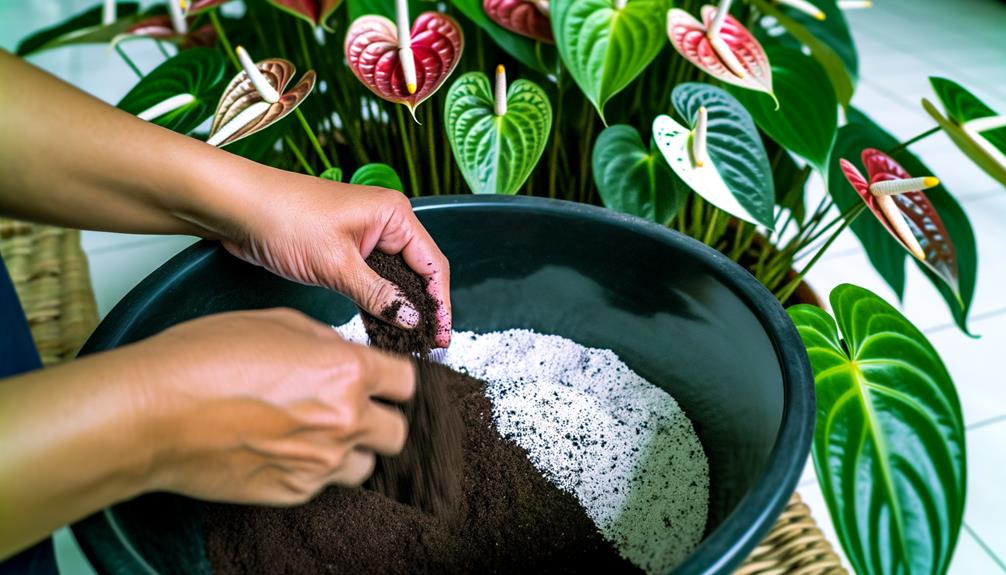
After achieving the best pH balance, it’s time to enhance soil aeration and moisture retention by incorporating perlite and vermiculite into your Anthurium mix.
Perlite, a volcanic glass, enhances soil structure by creating air pockets, promoting root oxygenation and preventing compaction. Aim for a ratio of around 20-30% perlite in your mix.
Vermiculite, a hydrated mineral, excels in moisture retention, ensuring your Anthuriums have consistent access to water without becoming waterlogged. It also aids in nutrient retention. Add about 10-20% vermiculite to the mix for optimal results.
Both amendments work synergistically, balancing air and moisture, which is essential for Anthurium health. By incorporating these elements, you’re setting the stage for vibrant, healthy plants.
Coconut Coir Benefits
Coconut coir, derived from the husk of coconuts, provides excellent water retention and aeration properties, making it a valuable component in your Anthurium soil mix. Its lignin content supports microbial life, vital for nutrient absorption.
Here are three reasons to use coconut coir:
- Water Retention: Coconut coir retains moisture without becoming waterlogged, preventing root rot.
- Aeration: Its fibrous structure enhances soil aeration, guaranteeing roots receive ample oxygen.
- pH Neutrality: With a near-neutral pH, it maintains an ideal growing environment, avoiding acidity issues.
Using coconut coir guarantees your Anthuriums have a balanced, breathable, and moisture-retentive medium. This aids in robust growth and vibrant blooms, perfect for gardeners aiming to meet their plants’ needs thoroughly.
Mixing Ratios

To create a favorable growing environment for Anthuriums, it’s essential to understand the exact mixing ratios of coconut coir with other key components in the soil blend.
Start with 40% coconut coir for its outstanding water retention and aeration properties.
Add 30% orchid bark to improve drainage and provide structural integrity.
Mix in 20% perlite to further enhance aeration and prevent compaction.
Finally, incorporate 10% charcoal to filter impurities and maintain soil health.
This balanced blend ensures ideal root oxygenation while retaining enough moisture, essential for Anthuriums’ well-being.
Testing and Adjusting Soil

After optimizing moisture retention, it’s important to periodically test and adjust your soil mix to guarantee your Anthuriums thrive.
Start by measuring soil pH; Anthuriums prefer slightly acidic conditions, around 5.5 to 6.5. Use a soil pH meter or pH testing kit for accuracy. If the pH is too high, incorporate sphagnum peat moss to lower it. Conversely, if it’s too low, add dolomitic lime.
Check for nutrient balance by conducting a soil nutrient test. Assure essential macronutrients—nitrogen, phosphorus, potassium—are present in sufficient quantities. If deficiencies are detected, amend the soil with appropriate fertilizers.
Evaluate soil aeration by observing root health; compacted soil indicates poor aeration. Mix in perlite or orchid bark to improve air circulation.
Regularly reassessing soil conditions secures your Anthuriums flourish.
Conclusion
By following this guide, you’ll maximize your Anthuriums thrive in a peak environment.
Did you know that Anthuriums can enhance indoor air quality by removing up to 87% of toxins in just 24 hours?
With the correct soil mix, your plants won’t only look stunning but also contribute to a healthier living space.
Remember, the key lies in balancing organic matter, adequate drainage, and the appropriate moisture levels.
Happy planting!



